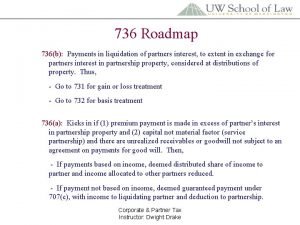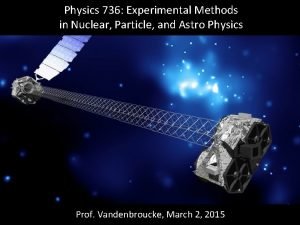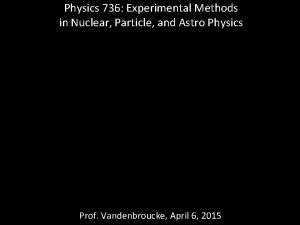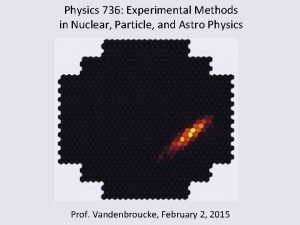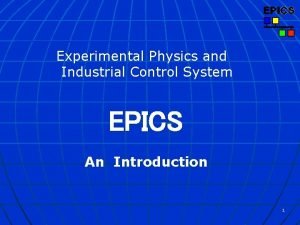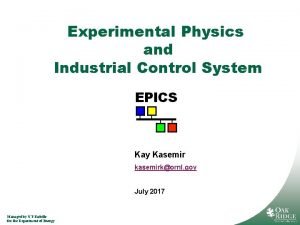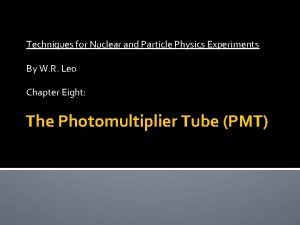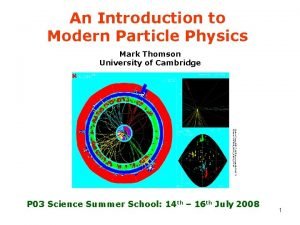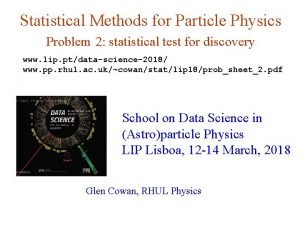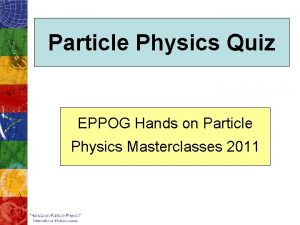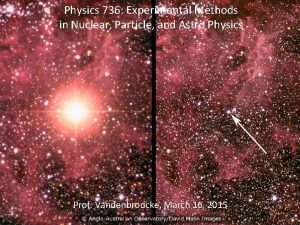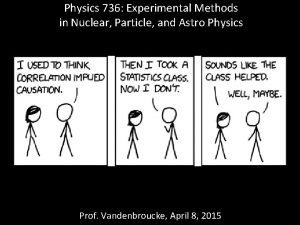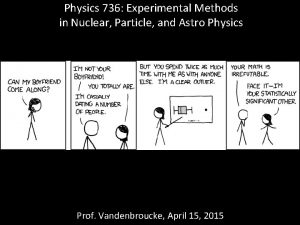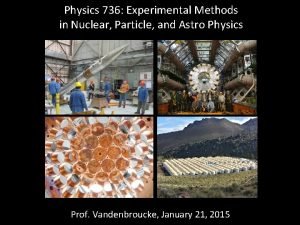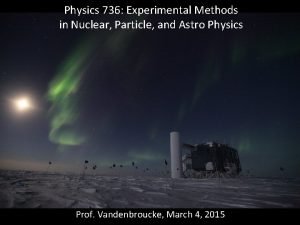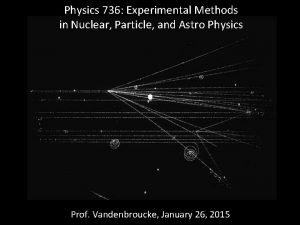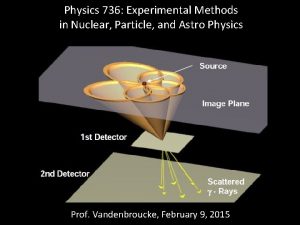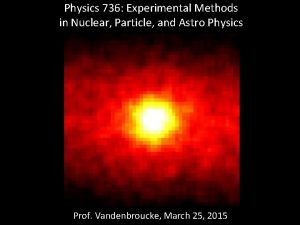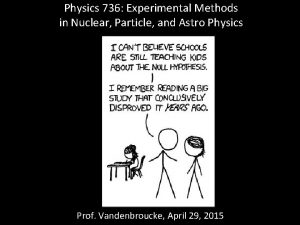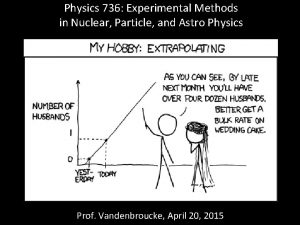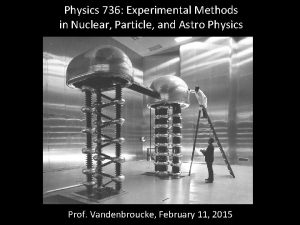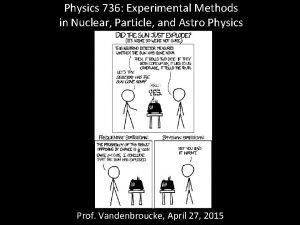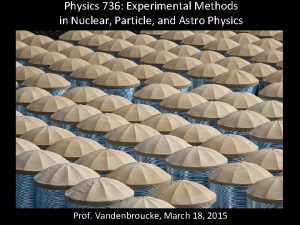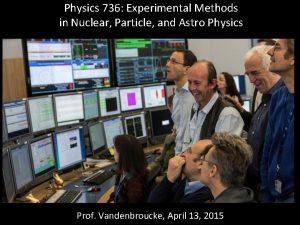Physics 736 Experimental Methods in Nuclear Particle and


















- Slides: 18

Physics 736: Experimental Methods in Nuclear, Particle, and Astro Physics Prof. Vandenbroucke, February 4, 2015

Announcements • • Problem Set #1 due Thursday at 5 pm in Ian Wisher’s mailbox Read Tavernier 3. 6 -3. 9 for Mon (Feb 9) Read Tavernier 4. 1 -4. 3 for Wed (Feb 11) Office hour today 3: 45 -4: 45 (Chamberlin 4114)

Compton scattering • Elastic scattering of photon and electron • Typically a high energy photon transfers energy to a low energy electron • “Inverse” Compton scattering: high energy electron transfers energy to a low energy photon • Can be useful for photon detection • Can also be a nuisance: changes photon direction • Cross section given by Klein-Nishina formula: • Low-energy limit is energy independent – Scattering off single electrons: Thomson scattering – Coherent scattering off bound electrons in atom: Rayleigh scattering

Angular distribution of Compton scattering • At high energies, outgoing photon direction similar to incoming photon direction • At low energies, direction is randomized more

Pair production • • • Photon is converted to an electron-positron pair Cross section rises quickly from threshold to a constant value at high energy At high energy, mean free path for pair production is X 0*9/7 Opening angle between electron and positron decreases with photon energy Electron and positron produced preferentially in the polarization plane of the gamma ray

Fermi Large Area Telescope: a pair-production telescope for gamma-ray astronomy

Photo-disintegration / photo-dissociation • • Reverse of fusion Nucleus absorbs gamma ray Excited nucleus decays More likely for heavy than light nuclei

Summary of photon interactions in matter pair production • A single photon interacts with a probability proportional to absorber thickness (for thin absorbers) • A beam of photons is attenuated exponentially with distance

Photoelectric absorption edges • Electron binding energies in lead (ke. V): 88. 0, 15. 9, 15. 2, 13. 0, 3. 9, 3. 6, 3. 1, 2. 6, 2. 5

less absorption Absorption of a photon beam by matter photoelectric Compton pair production • Number (not energy) of photons in a beam is attenuated exponentially • Absorption length inversely proportional to cross section

Strong interactions • So far we have focused on electromagnetic interactions: ionization loss, bremsstrahlung, photoelectric, pair production • High energy hadrons (protons, neutrons, pions, …) can also undergo strong interactions in matter • Inelastic: produces quarks which hadronize to mesons or baryons • Non-hadrons (electrons, muons, neutrinos, …) do not undergo strong interactions • Because strong force has a very short range, strong cross section at high energy (above 1 Ge. V) is same order of magnitude as geometric cross section of nucleus • 1 barn = 10 -24 cm 2 • Proton radius ~ 1 fm, area ~30 millibarn • Nucleus of atomic number A has cross section given approximately by

Strong interaction cross section grows slowly with energy Simple estimate surprisingly accurate

Hadronic (strong) interaction length • Mean free path between hadronic interactions, for protons in matter • Number density of nuclei in matter: N = ρNA/A • For typical solids, between 10 and 100 cm • Typically larger than radiation length X 0 by factor of a few • Example: air (Nitrogen A = 14)

Spallation • Collision with heavy nucleus breaks it into smaller nuclei • Can occur in space, atmosphere, rock, accelerators • Cosmic rays hitting atmosphere produce Carbon-14 (used for carbon dating) and other cosmogenic nuclei • Unstable spallation products in cosmic rays can be used as clocks • In addition to lighter nuclei, extra neutrons typically liberated: spallation neutron sources • Example: 1 Ge. V proton on lead produces 25 neutrons (useful source of neutrons)

Photonuclear interactions • Counter-intuitively, photons can undergo strong interactions with nuclei • Gamma-ray produces virtual quark-antiquark pair that interacts with nucleus • Excitation of nucleus can cause dipole (excess protons on one side) which results in resonant absorption (“giant dipole resonance”, GDR)

(Weak) interactions of high energy neutrinos in matter • In the high-energy regime (above ~30 Ge. V), interactions are dominated by deep inelastic scattering (neutrinos interact with quarks in nuclei) • Charged-current and neutral-current interactions • Cross section increases with energy

The Glashow resonance • An alternative interaction to DIS • Only possible for electron anti-neutrinos, due to presence of atomic electrons in matter • Resonant production of W-, which decays • Resonance is at neutrino energy of 6 Pe. V • W- branching ratios: – 68% quark + antiquark (hadronic shower) – 11% tau + tau antineutrino (tau track) – 11% mu + mu antineutrino (mu track) – 10% electron + electron antineutrino (electromagnetic shower)

Energy loss of muons in ice Photonuclear interactions of muons (or electrons or taus): energy transfer to nucleus via photon, producing energetic hadrons (like a hadronic interaction of a proton)
 736b payments
736b payments Experiment 736
Experiment 736 736
736 Cherenkov spectrum
Cherenkov spectrum Lesson 15 nuclear quest nuclear reactions
Lesson 15 nuclear quest nuclear reactions Fisión nuclear vs fision nuclear
Fisión nuclear vs fision nuclear Experimental vs non experimental
Experimental vs non experimental Research approaches and designs
Research approaches and designs Experimental vs non experimental research
Experimental vs non experimental research Non experimental design vs experimental
Non experimental design vs experimental Nonexperimental study
Nonexperimental study Physics topic 12
Physics topic 12 Experimental physics and industrial control system
Experimental physics and industrial control system Experimental physics and industrial control system
Experimental physics and industrial control system Experimental physics and industrial control system
Experimental physics and industrial control system Pmt particle physics
Pmt particle physics Mark thomson modern particle physics
Mark thomson modern particle physics Particle physics
Particle physics Particle physics practice quiz
Particle physics practice quiz
